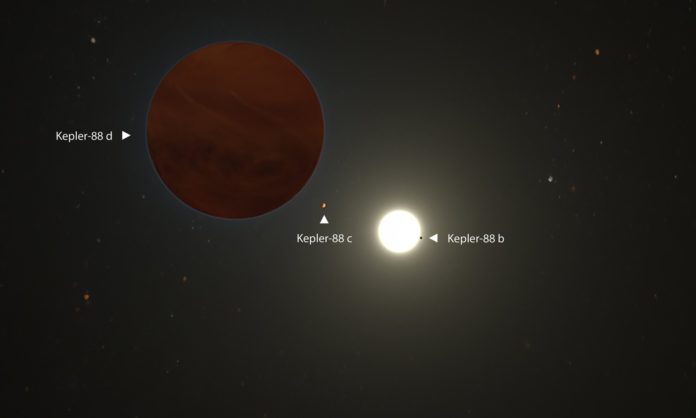About three times the mass of Jupiter, the planet dubbed as Kepler-88 d in a distant planetary system is the most massive planet in the Kepler-88 planetary system.
The discovery, led by the University of Hawaii Institute for Astronomy (UH IfA), is based originally on the data gathered at W. M. Keck Observatory on Maunakea in Hawaii. Using the High-Resolution Echelle Spectrometer (HIRES) instrument on the 10-meter Keck I telescope, scientists confirmed that the planet orbits its star every four years, and its orbit is not circular, but elliptical.
In Kepler-88 planetary system, two planets Kepler-88 b and c orbit much closer to the star.
Those two planets have a bizarre and striking dynamic called mean motion resonance. The sub-Neptune sized planet b orbits the star in just 11 days, which is almost exactly half the 22-day orbital period of planet c, a Jupiter-mass planet.
Both planets orbit in clockwise direction efficiently in such a way that it appears like a parent pushing a child on a swing. Every two laps planet b makes around the star, and it gets pumped. The outer planet, Kepler-88 c, is twenty times more massive than planet b, and so its force results in dramatic changes in the orbital timing of the inner planet.
The newly discovered planet adds another dimension to astronomers’ understanding of the system.
Dr. Lauren Weiss, Beatrice Watson Parrent Postdoctoral Fellow at UH IfA and lead author on the discovery team, said, “At three times the mass of Jupiter, Kepler-88 d has likely been even more influential in the history of the Kepler-88 system than the so-called King, Kepler-88 c, which is only one Jupiter mass. So maybe Kepler-88 d is the new supreme monarch of this planetary empire – the empress.”
Kepler-88 d has three times the mass of Kepler-88 c, making the newly found planet the most massive one known in this system. ANIMATION CREDIT: W. M. KECK OBSERVATORY/ADAM MAKARENKO
“Perhaps these extrasolar sovereign leaders have had as much influence as Jupiter did for our solar system. Such planets might have promoted the development of rocky planets and directed water-bearing comets toward them.”
Scientists are now searching for similar royal planets in other planetary systems with small planets.
Journal Reference:
- The Discovery of the Long-Period, Eccentric Planet Kepler-88 d, and System Characterization with Radial Velocities and Photodynamical Analysis. DOI: 10.3847/1538-3881/ab88ca
